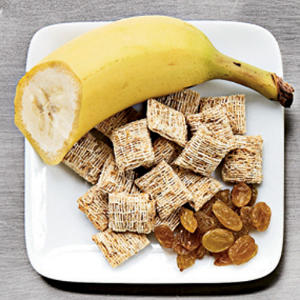Fortifying With Fiber: Is it Good For You?
 According to the 2009 HealthFocus USA Trend Report, nearly half of all shoppers are trying to increase the fiber in their diets, and 43% are looking for foods that are high in fiber. That should be easy, considering the hundreds—if not thousands—of new fiber-fortified foods in our groceries, such as dairy products like yogurt and milk, fruit juices, chewy granola bars, and even desserts.
According to the 2009 HealthFocus USA Trend Report, nearly half of all shoppers are trying to increase the fiber in their diets, and 43% are looking for foods that are high in fiber. That should be easy, considering the hundreds—if not thousands—of new fiber-fortified foods in our groceries, such as dairy products like yogurt and milk, fruit juices, chewy granola bars, and even desserts.
But the problem is that nutrition scientists contend that all fiber is not created equal—and eating a diet rich in naturally occurring fiber sources (i.e., fruits, vegetables, and whole grains) will do more for your health than eating products that normally lack fiber but are now fiber fortified.
Fiber additives like inulin, maltodextrose, and polydextrose may not provide the same health benefits that you’d get eating foods with natural fibers.
We’re supposed to eat 14 grams of fiber per every 1,000 calories, but most of us get about 14 grams total for the day, or less than half of what is recommended. Fiber is important for a variety of reasons. Its main benefits include:
Improved digestive health: More than 100 studies have shown that fiber increases stool bulk, which should help speed transit time in the gut.
Protection against heart disease: A diet low in fat and saturated fat but rich in soluble fiber can help reduce cholesterol levels and decrease the risk of heart disease. Some studies have found that those who eat fiber-rich diets suffer fewer heart attacks. The Food and Drug Administration found sufficient scientific evidence to allow a health claim on foods that contain soluble fiber in certain quantities.
Cancer-fighting properties: Fiber may also help reduce the risk of certain cancers, including colorectal cancer. Some studies have found a link between a high-fiber diet and reduced risk for breast cancer, but this is inconclusive.
Blood-sugar control: Studies also show that fibers help reduce the blood-sugar response of carbohydrate-containing foods by slowing down the digestion.
Weight control: Several studies have found that those who consume higher-fiber diets weigh less than those who eat diets low in fiber. In addition, Tufts University researchers found that by adding 14 grams of fiber a day to women’s diets, their average weight loss was more than four pounds in four months.
Registered dietitian Danielle LaFata, MA, RD, CSSD, of Athletes’ Performance in Phoenix, Ariz., advises clients to “look beyond fiber claims and to the ingredient list, to make sure that the products you’re eating aren’t too high in added sugars, artificial ingredients, additives, or preservatives. It’s better to eat a piece of fruit or have some nuts to get your fiber than eat a high-fiber food that has an ingredient list that’s 10 lines long,” she advises.
One thing no one disputes is that the new fiber-fortified foods are not a substitute for a diet rich in fruits, vegetables, whole grains, and other fare that is naturally full of fiber, including those in the list below (and in these tasty recipes).
•1 cup cooked beans: 10 to 13 g of fiber
•Ready-to-eat bran cereal, 1/2 cup: 10 g
•Beans, lentils, 1/2 cup: 5 to 8 g
•Berries, 1 cup: 5 to 9 g
•2 rye crackers: 5 g
•Sweet potato, 1 medium: 5 g
•Green peas, 1/2 cup: 4.5 g
•Whole-wheat English muffin: 4.5 g
•1 small pear: 4.5 g
•Mixed vegetables, cooked, 1/2 cup: 4 g
•Potato, baked, 1 medium: 4 g
•Stewed prunes, 1/2 cup: 4 g
•Dried figs, 1/4 cup: 4 g
•Oat bran, 1/4 cup: 4 g
•Almonds, 1 ounce: 3.5 g
•Apple, 1 medium: 3.5 g
•Banana, orange, 1 medium: 3 g
•Tomato paste, 1/4 cup: 3 g
•Broccoli, cooked, 1/2 cup: 3 g
•Beets, 1 cup: 3 g
Article courtesy of Julie Upton, RD, for Health.com
- Tags: Diet and Nutrition
- Professional Medical














Comments 0